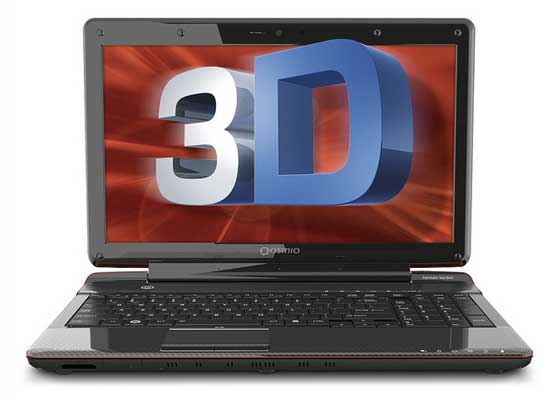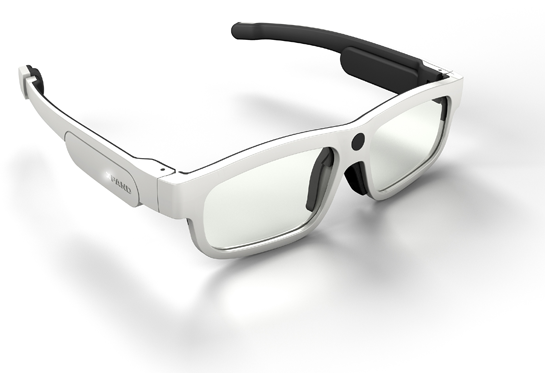Over at TIME.com, I reviewed Sony’s Personal 3D Viewer, which lets you strap two tiny OLED screens to your head for 3D movie watching and game playing. It’s an unusual gizmo, and at $800, it isn’t cheap. But I liked the 3D effect way more than almost anything else I’ve seen.
Tag Archives | 3D
HP 3D: Passive vs. Active
HP announced a 3D PC display and a 3D PC today. To me, at least, the most interesting thing about them is that the company chose a different flavor of 3D for each device.
First the display. Its official moniker is the HP 2311gt 3D monitor, and it’s a 23″ LED-backlit display. Like most 3D movies you see in theaters, the 3D is passive, which means that its uses polarized glasses that don’t have any embedded electronics and don’t cost a lot of money. In fact, the display and two set of glasses go for $299.99, or about what you might pay for two pair of active-shutter glasses alone.
No comments
U.S. Moviegoers Lose Interest in 3D
I don’t mean to suggest that I know more about the movie business than Jeffrey Katzenberg. But I’m relieved to see that the gut instinct I had all along seems to be fact: 3D movies were, are, and always will be a fad.
I wonder how long it’ll take until Hollywood and consumer-electronics companies conclude that the magic of 3D isn’t that magical at home, either?
3 comments
Sony’s 3D HDTV Headset: Hey, This is 3D Even I Like!

 I’m in Berlin for IFA, the giant conference that’s Europe’s answer to the U.S.’s Consumer Electronics Show. I’ll be writing about some of the products I learn about this week–and one of the most interesting ones so far is Sony’s HMZ-T1, a personal TV headset that lets you watch movies and TV and play games with an image projected right in front of your eyes, producing a virtual theater-like effect.
I’m in Berlin for IFA, the giant conference that’s Europe’s answer to the U.S.’s Consumer Electronics Show. I’ll be writing about some of the products I learn about this week–and one of the most interesting ones so far is Sony’s HMZ-T1, a personal TV headset that lets you watch movies and TV and play games with an image projected right in front of your eyes, producing a virtual theater-like effect.
The idea isn’t new–in fact, it’s an updated take on Glasstron, which Sony introduced back in 1997. But the new version has been thoroughly updated. It’s got twin 720P OLED displays, 3D, and 5.1 channel sound. You plug the HMZ-T1 headset into a converter box that connects to your TV. A cable delivers both an image and power–the headset doesn’t have a battery, which let Sony design something that’s fairly lightweight (14.8 ounces) and comfortable given how much electronics you’re strapping to your skull.
5 comments
Toshiba’s No-Glasses 3D Laptop is About to Hit Stores
 Last year, Toshiba showed me an experimental laptop that could do 3D without special glasses–and even do 3D on one part of the screen while another part was in standard 2D. Back them, it was just a technology demo. But the company has announced the Qosmio F755 3D, a model based on the tech I saw. It has a 15.6″ display and an Intel Core i7 CPU, and arrives on August 16th for $1699.99.
Last year, Toshiba showed me an experimental laptop that could do 3D without special glasses–and even do 3D on one part of the screen while another part was in standard 2D. Back them, it was just a technology demo. But the company has announced the Qosmio F755 3D, a model based on the tech I saw. It has a 15.6″ display and an Intel Core i7 CPU, and arrives on August 16th for $1699.99.
2 comments
Coming in 2012: 3D Glasses That Aren’t Incompatible and Pricey
Panasonic, Samsung, Sony, and 3D glasses maker XpanD have announced that they’re working together to design a specification for Bluetooth-enabled 3D glasses that will be compatible with HDTVs from all the above makers. They intend to ship them in 2012, and the glasses should work with existing 3D-capable TVs as well as new ones. It’ll eliminate the current hassle of having to buy glasses made by your TV’s manufacturer, and will presumably help to drive down prices for the specs.
To which I say: GOOD! GOOD! WHAT TOOK YOU SO LONG?
2 comments
Remember Polaroid? That Company That Made Unsanitary 3D Glasses?
In “Polaroid’s SX-70: The Art and Science of the Nearly Impossible,” I had a lot to say about a single fascinating Polaroid camera. But almost everything Polaroid did was fascinating, and it didn’t all involve instant photography. I came across a lot of stuff that didn’t fit into the SX-70 story. Such as this…
Before Edwin Land invented the instant camera, he invented synthetic polarizers. He realized in the 1930s that one application of the technology would be 3D movies, but it wasn’t until 1952 that the idea took off–and only briefly at the time.
In its May 16th 1953 issue, the New Yorker published a story on Polaroid’s 3D glasses and concerns over whether they were unsanitary. Polaroid had been selling instant cameras for five years at that point, but they didn’t merit a mention in the story–Land was apparently still more famous as the polarizer guy.
If you replaced the references to Polaroid with RealD and the one to Bwana Devil with, say, Thor, you could practically republish this story today. Fifty-eight years later, people are still freaking out over germy 3D glasses and figuring out ways to disinfect them.
And hey, I just learned that Polaroid Eyewear–a separate company from the current version of the Polaroid that sells photography-related stuff, but descended from the original Polaroid–is selling 3D glasses all over again.
No comments
Bad 3D Invades E3
 So there I was, playing a demo of Silent Hill: Downpour in Konami’s E3 booth, and all I could think about was how I’d rather be at a different kiosk.
So there I was, playing a demo of Silent Hill: Downpour in Konami’s E3 booth, and all I could think about was how I’d rather be at a different kiosk.
You see, I was playing Silent Hill’s Playstation 3 version, with a pair of stereoscopic 3D glasses affixed to my head. The guy next to me was playing the Xbox 360 version in 2D. The difference in smoothness and visual fidelity was all too obvious.
2 comments
Now Here, the Biggest Movie Breakthrough in Decades: 2D!

I enjoyed attending Qualcomm’s Uplinq conference on mobile technology this week. Even the two presentations that involved having to wear funny glasses as stuff in 3D was projected for us–mostly because in both cases the source for the 3D video was a smartphone, which was kind of cool.
As usual, though, my instinctive response was to bristle at the 3D for being blurry and gimmicky. I had a random thought, which I tweeted:
If all we had was 3D TV/movies/games, and someone invented 2D, it would be hailed as a breakthrough. "No glasses–and it's sharp!"
— Harry McCracken (@harrymccracken) June 2, 2011
5 comments
3D Cooling Off?
Are audiences–in the US, anyhow–losing interest in 3D movies? I sort of hope so, and the New York Times’ Brooks Barnes and Michael Cieply see signs that they might be.



